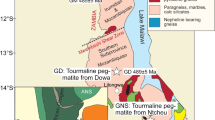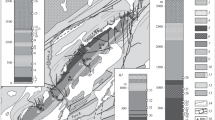Abstract.
Equilibrium melt trace element contents are calculated from Proterozoic Nain Plutonic Suite (NPS) mafic and anorthositic cumulates, and from plagioclase and orthopyroxene megacrysts. Assumed trapped melt fractions (TMF) <20% generally eliminate all minor phases in most mafic cumulate rocks, reducing them to mixtures of feldspar, pyroxene and olivine, which would represent the high-temperature cumulus assemblage. In anorthosites, TMF <15% generally reduce the mode to a feldspar-only assemblage. All model melts have trace element profiles enriched in highly incompatible elements relative to normal mid-ocean ridge basalt (NMORB); commonly with negative Nb and Th anomalies. Most mafic cumulates yield similar profiles with constant incompatible element ratios, and can be linked through fractional crystallization. High K–La subtypes probably represent crust-contaminated facies. Mafic cumulates are inferred to belong to a tholeiitic differentiation series, variably contaminated by upper and lower crustal components, and probably related to coeval tholeiitic basaltic dyke swarms and lavas in Labrador. Model melts from anorthosites and megacrysts have normalized trace element profiles with steeper slopes than those calculated from mafic cumulates, indicating that mafic cumulates and anorthosites did not crystallize from the same melts. Orthopyroxene megacrysts yield model melts that are more enriched than typical anorthositic model melts, precluding an origin from parental melts. Jotunites have lower K–Rb–Ba–Y–Yb and higher La–Ce than model residues from fractionation of anorthositic model melts, suggesting they are not cosanguineous with them, but provide reasonable fits to evolved mafic cumulate model melts. Incompatible element profiles of anorthositic model melts closely resemble those of crustal melts such as tonalites, with steep Y–Yb–Lu segments that suggest residual garnet in the source. Inversion models yield protoliths similar to depleted lower crustal granulite xenoliths with aluminous compositions, suggesting that the incompatible trace element budget of the anorthosites are derived from remobilization of the lower crust. The similarity of the highly incompatible trace elements and LILE between anorthositic and mafic cumulate model melts suggests that the basalts parental to the mafic cumulates locally assimilated considerable quantities of the same crust that yielded the anorthosites. The reaction between underplating basalt and aluminous lower crust would have forced crystallization of abundant plagioclase, and remobilization of these hybrid plagioclase-rich mushes then produced the anorthosite massifs.
Similar content being viewed by others
Author information
Authors and Affiliations
Additional information
Electronic Publication
Rights and permissions
About this article
Cite this article
Bédard, J.H. Parental magmas of the Nain Plutonic Suite anorthosites and mafic cumulates: a trace element modelling approach. Contrib Mineral Petrol 141, 747–771 (2001). https://doi.org/10.1007/s004100100268
Received:
Accepted:
Issue Date:
DOI: https://doi.org/10.1007/s004100100268




